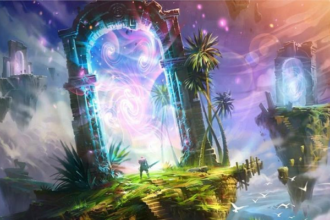Scholastic Exploration and National Treasure
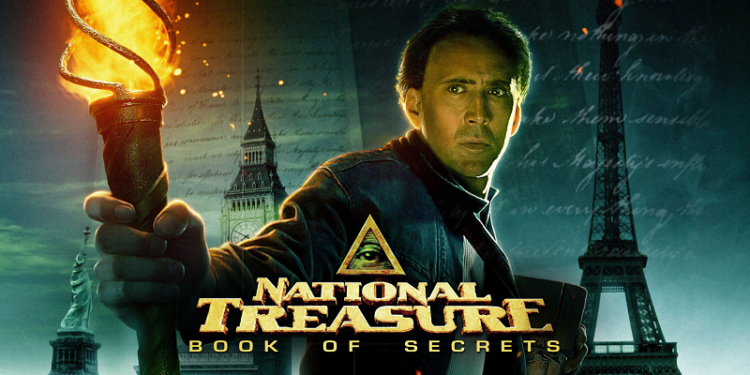
Happy Fourth of July, Americans! I’m normally an easy sell for the holiday. Hanging out in the heat, drinking booze, grilling out, and watching stuff blow up to rock and roll – what’s not to like? However, it’s been hard for me to have the same zeal for the specific brand of holiday patriotism I typically possess this time of year. I find myself thinking of a quote from Snowcrash more than I should. Even in that dystopian future, America still does three things better than the rest of the world – movies, music, and microcode. Hiro is a lot of things, but he ain’t wrong. So, I’m here on this holiday to do something wholly American. Please enjoy this piece in defense of National Treasure and scholastic exploration in tabletop games. Yes, the Nic Cage franchise.
Named After the Dog
It’s easy to claim National Treasure is just Indiana Jones Light. Both are about historians who seek to claim artifacts of historical and intrinsic value before the opposition does. Each focuses on legends that have entered our collective imaginations. Here the franchises diverge. It’s true that similar beats exist in both, but that’s more the product of the adventure genre than it is specific to the films themselves. In fact, I’m pretty sure I could make a compelling argument that Harold and Kumar Go to White Castle has more in common with Indiana Jones and the Last Crusade than the second National Treasure film. What I am saying it, we need to separate the story formula from the content to get the full picture.
The Indiana Jones franchise isn’t really about the adventure or the artifacts. It’s about Indy. This is why handing over the franchise to a character that isn’t Indiana Jones doesn’t work that well. It’s like saying, “Here’s a James Bond film about his son, Brian Bond.” Even though we could get the exact same story beats and theme, the engagement just isn’t likely to be there. We already accept that multiple actors portray James Bond, and that the stories adhere to a specific era’s sensibilities and concerns. James Bond is our emotional anchor point, not the spy adventure itself.
I don’t think anyone would have been as upset at the fourth installment of the Indiana Jones franchise if “Old Indy” was just book-ending the tale as a flashback, and it still mostly involved Indiana Jones running around and doing stuff. People might decry certain elements – the fridge, alien magic, etc. – but these would likely be a lot less objectionable. These are just tangible details. While you should absolutely read this article – and most other things written by Film Critic Hulk if you care about movie and entertainment criticism – the nickel takeaway is that things stick out as reasons why things are bad because of the inability to articulate the nuanced reasons why you don’t actually like something. It’s less about the fridge and more about the supplanting of Indy and the complete deconstruction of the Indiana Jones mythos without any context.
This is brings us to a critical point of my argument: no one gives a shit about Benjamin Gates.
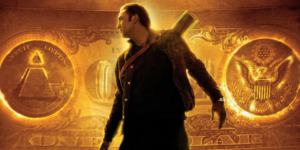
Opening the Gates
Be honest. How many of you remember off-hand that Nicolas Cage’s character in National Treasure is named Benjamin Gates? Do you remember Abigail Chase is the character Diane Kruger portrays? I’d wager that most of you do not recall their names. It’s easy to write them off as not nearly as iconic as Indiana Jones or Marion Ravenwood – and you’re obviously right about that point – but it’s deeper than that. Let’s look at the box offices, for a moment.
By any measuring stick other than critical acclaim, the National Treasure movies are a massive success. The budgets for the films clock in at a fairly restrained $100M and $130M. The first film made $348M at the box office, and the second made $457M. By contrast, Indiana Jones and the Kingdom of the Crystal Skull cost $185M and made $786M. In other words, for every dollar spent on Indy 4, the studio made $4.25, and for every dollar spent on National Treasure: Book of Secrets the studio made $3.52. This is including POSITIVE critical reactions and immediate fan reactions to Indy 4 upon release. Both National Treasure films received largely negative reviews at the time of release. This is all pretty impressive for an original property, albeit prior to the comic book boom of the late 2000’s.
Family Friendly
Stepping back to the question of character identity, we have to recognize the National Treasure films are family-oriented affairs. Both of the films – and the pending third film – are PG. These aren’t the soft-PG films of the 80’s, either. There is some gunfire in the first film, but really harms no one. The deaths in the film aren’t particularly graphic, and they generally serve a larger sense of redemption or arc completion. I mean, even Sean Bean doesn’t die.
The “family film” label is something of a derogatory label, as people often just use it as “bad film that makes a shitload of money.” On the surface, it seems like this applies. Rotten Tomatoes – remember, this was in the Before Time and thus wasn’t the steaming pile it is now – clocks both films around 35%. However, this movie isn’t quite the same as other family films we often see. Again, this is due to the characters.
You can’t sit there and tell me with a straight face that kids really love history nerd-turned-adventurer Benjamin Gates. Even computer-nerd Riley isn’t really a kid-focused character or anything. These characters are 100% for the parents. This is a big shift from most family movies. Take Transformers. Kids probably aren’t going crazy for Shia LaBeouf – regardless of whether he’s an actual cannibal or not. However, you have Optimus, Bumblebee, and Starscream for the better class of child. National Treasure doesn’t have anything like that. Instead, the child content is 100% the adventure itself – with the purposeful framing of having the young Benjamin at the beginning of the film.
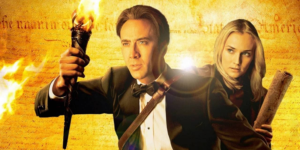
Movies are SO Educational
One of the funniest things about National Treasure is that the movie has altered the way tours are conducted at the National Archive. There is a disclaimer that no such restoration room exists, and that, no, there is no secret map on the back of the Constitution. While it’s easy to laugh at the naiveté of the average moviegoer, I am not laughing. I think it’s absolutely amazing. It sparked an interest in a critical historical building that most people never thought about, and encouraged children to become interested in the history of the Constitution. Whatever the flaws of the film, that’s fantastic. It’s also why National Treasure is a model for scholastic exploration gameplay within your tabletop game: the movie hinges on everyone being academic experts.
Yes, the movies are about treasure, but they aren’t about wealth. Instead, each “good guy” cares about a specific academic objective. Benjamin Gates wants to prove his family isn’t a bunch of conspiracy theorists. Riley wants to make a mark on the world outside of his previous life as an IT monkey. Abigail wants to ensure the preservation of history and make a name for herself as an academic. We even find out Ben’s disapproving father, Patrick, is a respected historian and has his own obsession – Cibola. In fact, the films don’t limit this to good guys. In the second film, the main villain wants to ensure the world remembers the last name Booth for more than the man who shot Lincoln.
Along the way, it’s not might that helps the heroes find their way to success. Indy has his fair share of scholastic mysteries, but he also punches nazis, fights evil magic, blows up zeppelins, and gets into dog fights. Ladies swoon over him – and rightfully so. Benjamin Gates is trained as a Navy SEAL, but that only comes into play because he’s able to swim well, hold his breath, climb on things, and in general run away well. He’s not punching people or anything like that. Largely, he just reads things.
Take a Look, It’s in a Book
The main characters of National Treasure are all nerds, and it’s awesome. The revelation of information informs every transition and story element of the movies. Even the action sequences revolve around the idea. Kidnappings and assaults occur not to injure or kill the opposition, but instead to force characters to reveal critical information that will help the opposition achieve the goal before the heroes. In short, every situation is a ticking-clock situation with a binary outcome. If Sean Bean discovers the treasure, Nicolas Cage doesn’t. If Ed Harris finds the city of gold first, Helen Mirren and Jon Voight don’t get the credit.
The first film opens with the mystery provided in the flashback being solved. This isn’t solved through raw exploration, tracking down informants, or anything else like that. It’s solved by Riley creating a computer model of environmental patterns after Benjamin Gates performed what we can only assume is a truly staggering amount of colonial naval research – presumably something he focused on while achieving his rank in the Navy. Once he finds the object of the first mystery, Benjamin relies on context clues to find the next piece of the puzzle, which is a riddle. From there, it’s a series of scholastic riddles centered around colonial American history, complete with the inclusion of an American fascination: the Knights Templar.
Historical documentation drives the conflict of the second film. Ed Harris shows up to a lecture and presents missing pages from the diary of John Wilkes Booth, indicating that an ancestor of Benjamin Gates was in on the conspiracy to assassinate President Lincoln. From there, we are treated to a history of American foreign policy relations in our first 100 years, including an aside into furniture. We even get a new wholly American conspiracy theory – that presidents are told all of the secrets the public can never know as soon as they take office. This includes Area 51, the JFK assassination, Watergate, etc.
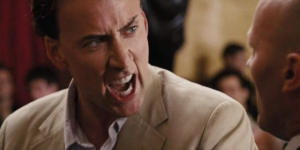
Scholastic Exploration and Academic Modeling
It should be pretty clear that despite your feelings on the films – I’m firmly in the positive camp – it’s largely an academic-drive adventure. Every beat of the adventure is driven by the characters seeking to prove or disprove their findings and research. If this isn’t a model worthy of taking into your games, I don’t know what is.
Letting academia drive portions of the plot is something more games could stand to do, my own included. Not only does it let players drive the story, it makes the world react to what the players pursue. If a wizard is creating a spell, having another wizard challenge her over the true author and creator of the spell is good conflict. If someone has a noble heritage, challenging them over the legitimacy of their title and patents of nobility is solid. Maybe a magical artifact the players possess is stolen, and their documentation is forged. Regardless, it is then up to the players to spring into academic action to track down an answer to the problem. This isn’t likely something they can just stab their way out of, after all.
Okay. If they do ENOUGH stabbing, they could stab their way out of just about anything, but if you are running that kind of campaign, you already know that. Nothing wrong with that, just, you know, know your audience.
Last Words
I’m of the belief you can learn something from just about everything. In some cases it might simply be what not to do, but it’s still valuable. In other cases, you will be pleasantly surprised by something you do like. National Treasure doesn’t deserve its rep, but that doesn’t matter. There is so much good in it you can lift for your own purposes. If you haven’t seen it, give them a watch. If you have seen them, watch them again anyway. The particulars don’t necessarily matter, though you could do worse than supplanting the American history with your own game history and going from there. What matters is the beats, the action, and the transitions. These are all things the movies do extremely well.
Maybe when you’re waiting for the ribs to be done and you’re two or three bourbon sweet teas into the day, load it up on your streaming service and watch it. If nothing else, there are worse ways to spend your 4th.


